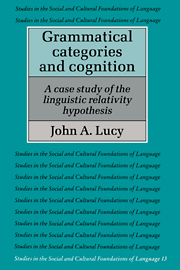2 - Comparison of grammatical categories: nominal number in English and Yucatec
Published online by Cambridge University Press: 19 January 2010
Summary
Introduction
An examination of the relationship of linguistic diversity to thought requires the identification and analysis of a specific case of such diversity. Ideally, following Whorf, the contrast would be of large-scale “fashions of speaking.” This ideal guides the approach taken here in two respects. First, the focus is on a structurally and semantically significant aspect of the grammar rather than on a little used or structurally marginal pattern. Second, some preliminary indications are given as to how these patterns fit together into larger semantic structures in each language.
It would also be desirable to investigate a substantial sample of languages. This is approximated here in that the linguistic characterizations and comparisons explicitly take account of typological data on an array of languages. Further, the analysis has been constructed, both methodologically and substantively, to facilitate extension to additional languages. However, detailed linguistic discussion will be provided only for American English and Yucatec Maya – the two languages for which cognitive assessments will be undertaken.
The phenomenon of concern in this chapter can be loosely labeled in traditional terms as nominal number marking. Notionally, it involves various indications of the multiplicity, number, quantity, or amount of some object of noun phrase reference relative to a predication. Formally, it includes such things as plural inflection, plural concord, and indication of singular or plural by modification of the lexical head of a noun phrase with a numeral or other adjective indicating quantity or specificity of amount. Nominal number has been chosen for several reasons. First, it is one of the most commonly encountered and most central noun phrase categories; as such it is ideal for comparative purposes.
- Type
- Chapter
- Information
- Grammatical Categories and CognitionA Case Study of the Linguistic Relativity Hypothesis, pp. 23 - 84Publisher: Cambridge University PressPrint publication year: 1992
- 1
- Cited by



